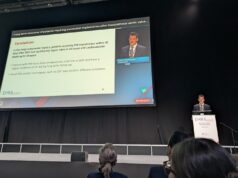
Sixty years ago, the first pacemaker implant was made in Stockholm, Sweden (Senning & Elmqvist) on 8 October 1958. The patient had atrioventricular block with recurrent Adams-Stokes attacks. These were prevented by the implant—although, it only functioned for a few hours. Pacing therapy was used for the remaining 43 years of the patient’s life, but he received more than 30 devices in this time. In this commentary, Richard Sutton reviews how pacing has come a long way since then.
The first implants used epicardial leads and very unreliable batteries. Medtronic founded by Earl Bakken in Minneapolis, USA, rapidly became the largest manufacturer. Conversion to endocardial leads took place in the 1960s and this was associated with a change in implanter from cardiac surgeon to cardiologist. The first dual chamber pacing system, VAT mode, appeared in 1962 (Nathan, Miami, US) but neither the leads nor the batteries were up to the challenge. Batteries leapt forward in the early 1970s with the advent of the lithium cell. The first batteries lasted more than 10 years but this was reduced by downsizing the cell in keeping with a desire to have smaller devices.
Sophistication
Dual chamber endocardial pacing emerged in 1976 (VDD mode), which was termed “physiological pacing” but pacing has since become more and more physiological. In the 1970s pacemakers became externally programmable which allowed the physician to tailor the device to individual patient needs.
Also in 1976, rate responsive pacing using a sensor became a real possibility with the activity sensor (VVIR). DDD pacing, invented by Funke of Germany, followed in 1978 and this quickly became DDDR. In the 1990s pacing was regarded as expensive therapy and many large clinical trials were conducted in the hope of proving that the more sophisticated devices were better but these largely failed. Nevertheless, the sophisticated devices continued to be preferentially selected. The most important recent development in cardiac pacing started in France in 1994 (Ritter & Mugica). This became known as cardiac resynchronisation therapy (CRT). It was shown to influence heart failure favourably and sometimes dramatically. Large clinical trials were undertaken from 2001, which subsequently have proved the efficacy of the therapy (providing there is delayed conduction in the left ventricle). The therapy also introduced the concept of non-response which regrettably affects about 30% of those treated.
In the early 2000s, devices became readily monitored through internet-based systems—remotely permitting communication of the device and the patient with the monitoring centre—avoiding many journeys to hospital for routine checks and offering the centre the ability to predict problems before they became symptomatic.
The latest pacing development was the leadless device, which was introduced at the beginning of the current decade. Presently, these are all single chamber ventricular pacemakers (VVIR) but soon we can expect dual chamber versions. The major advance is the abolition of the lead with all its attendant problems of fracture, sepsis, displacement and perforation but there is also greater comfort for the patient and an easier implant procedure. In CRT, His bundle pacing is receiving deserved attention as it appears to offer greater simplicity and possibly also efficacy.
Commercialisation
During the development of pacing companies have come, gone and merged. Now Medtronic continues with Abbott, Boston Scientific, Biotronik and Sorin as its competitors. Companies have generally behaved very ethically and have had extremely high standards of manufacture and patient safety. Despite their huge efforts recalls still occur but they are very few compared with the numbers manufactured. It is reasonable to appreciate that we will never make a perfect device.
Governments have become important players in the field recurrently demanding lower and lower prices from manufacturers, which has been very effective. Another effect beyond reducing prices is to reduce research and development budgets in pacing for bradycardia and even for CRT. Thus, the market is termed by manufacturers as flat and with low profit margins. This is sadly a complacent and negative attitude as pacing is an unfinished work.
The future
There are many patients in the developed world let alone lesser developed countries that would benefit from pacing but are never considered. This statement includes the UK where the implant rate is ~650 new cases/million population per year compared with figures of close to 1,000 for Germany, US, France, Belgium and Italy. The reasons for this cannot be explained by demographics as the UK’s are very similar to those in the other countries mentioned. As was pointed out by Rickards in the early 1980s the UK has less cardiologists and less cardiac facilities than the other mentioned countries. In the decade 2000-2010 the implant rate improved and was paralleled by growth in cardiac resources. Guidelines are too often not followed in the context of carotid sinus syndrome and even vasovagal syncope. Bradycardia patients still escape diagnosis and, therefore, therapy as shown by differences in implant rates in neighbouring general practices with identical demographics. Manufacturers could help here with greater educational efforts.
In developing countries, greater efforts by manufacturers will bring greater benefits for patients and rewards for companies but more innovative methods are required. Device implantation without fluoroscopy using simplified electrical electrophysiological study methods or ultrasound, improved hub and spoke care delivery, maintenance of simpler devices in production that allow cheaper prices could all contribute and manufacturers could play an important part.
Thus, it can surely be said that pacing is one of the most successful therapies available in medicine not just cardiology. It has a secure future in benefitting millions more patients when appropriately applied. All involved must play their parts.
Richard Sutton is Emeritus professor of Clinical Cardiology at Department of Cardiology, Hammersmith Hospital, National Heart & Lung Institute, Imperial College, London, UK.









